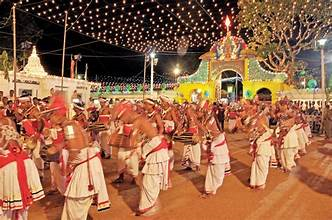…Kataragama…
Kataragama: A Sacred and Cultural Gem of Sri Lanka
Kataragama is one of the most revered pilgrimage sites in Sri Lanka, a place where ancient traditions and diverse religious practices converge. Situated in the southern part of the island, in the Uva Province, Kataragama is a town and shrine that holds immense significance for Buddhists, Hindus, and even Muslims, reflecting the pluralistic nature of Sri Lankan spirituality. The town is home to the Kataragama Temple, a sacred site dedicated primarily to Lord Skanda (also known as Murugan in Tamil), the Hindu god of war and victory. However, it is also a major site for Buddhist and Islamic pilgrims, making it a unique cultural and religious landmark.
Historical Significance
The origins of Kataragama trace back over 2,000 years. According to legend, Lord Skanda (Murugan) is believed to have arrived at Kataragama after a significant victory in the battle against the demon Soorapadman, a story central to Hindu mythology. The site became a prominent center for worship after the establishment of the Kataragama Devalaya, a shrine dedicated to Skanda in the 3rd century BCE, during the reign of King Devanampiya Tissa. The temple’s role as a religious center for various ethnic and religious communities grew over the centuries, further cementing its importance in the cultural and spiritual life of the region.
The Kataragama Temple Complex
The heart of Kataragama’s sacredness lies in the Kataragama Temple itself, which is visited by thousands of devotees every year. The temple complex includes several structures, each dedicated to different deities. While the central focus is the shrine to Skanda, there are also shrines for other deities, including Vishnu, Ganesha, and Shiva, reflecting the eclectic mix of religious influences at the site.
One of the most striking aspects of the Kataragama temple is its unique blend of Hindu and Buddhist practices. Buddhism is well represented at the temple, with the Sakyamuni Buddha and other Buddhist symbols incorporated into the worship rituals. The influence of Tamil and Sinhalese cultures is also evident, with offerings and rituals often being conducted in both Tamil and Sinhala languages. The peaceful coexistence of these practices at Kataragama makes it an embodiment of Sri Lanka’s religious tolerance and multicultural heritage.
Pilgrimages and Rituals
Kataragama is especially famous for its annual Perahera, a vibrant festival held in July or August. This event draws devotees from across Sri Lanka and beyond. The Kataragama Perahera is a spectacular procession with dancers, drummers, fire-walkers, and elephants parading through the town in honor of Lord Skanda. Pilgrims, many of whom come from Tamil Nadu, India, undertake religious journeys to Kataragama, often walking barefoot for days, in fulfillment of vows and in hopes of receiving blessings.
Throughout the year, visitors to Kataragama engage in various religious rituals. Votive offerings, such as flowers, coconuts, and incense, are common, as well as the ritual of fire-walking, where devotees walk on hot coals as an act of faith and devotion. This act, believed to invoke divine blessings, has become one of the most iconic rituals at the Kataragama temple.
Another significant ritual is the Kavadi Attam, a form of dance that devotees perform as an act of penance or thanks for favors received from Lord Skanda. Devotees often carry elaborate wooden structures adorned with peacock feathers and bells, balancing them on their shoulders or foreheads as they perform the dance.
The Sacredness for Multiple Faiths
What makes Kataragama particularly unique is its significance across different faiths. Hindus, Buddhists, and Muslims all view the site as sacred.
- Hindus believe that Kataragama is the place where Lord Skanda descended to defeat the demon Soorapadman and that his divine presence still resides there. The temple’s deity is deeply revered in Tamil Hinduism, with many Tamil devotees making pilgrimages to Kataragama as part of their religious duty.
- Buddhists also regard Kataragama as sacred due to its association with Sakyamuni Buddha. The Buddha is believed to have visited Kataragama during his lifetime to preach the Dhamma to the local inhabitants. In addition to the temple itself, there are several ancient Buddhist stupas and shrines in the surrounding area, further reinforcing its Buddhist heritage.
- Muslims also consider Kataragama sacred, particularly due to the presence of the Mawlan Sufi Shrine in the area. The shrine is dedicated to the Islamic saint Hazrat Makhdum Sharif, a Sufi mystic believed to have lived in the region in the 14th century. Muslim pilgrims visit Kataragama to seek blessings, creating a shared sense of sacredness that spans across different religious traditions.
Natural Beauty and Surroundings
Kataragama is not just a religious site; it is also located amidst stunning natural beauty. The town is nestled near the Yala National Park, one of Sri Lanka’s most famous wildlife reserves. The area is rich in biodiversity, with lush jungles, rivers, and hills providing a serene backdrop to the temple complex. The proximity to the park also means that many pilgrims combine their spiritual journey with a visit to the park, which is home to a variety of animals, including leopards, elephants, and exotic bird species.
The region’s tropical climate, combined with its natural beauty and religious significance, creates a unique atmosphere that is both calming and spiritually uplifting. Many pilgrims choose to meditate, reflect, or engage in personal prayers by the riverside or near the temples’ sacred trees, enhancing their spiritual connection with the place.
Conclusion
Kataragama is a remarkable testament to Sri Lanka’s diverse religious heritage and its longstanding tradition of religious tolerance. The town’s significance as a sacred site transcends sectarian boundaries, offering a space where different faiths coexist in harmony. For Hindus, Buddhists, and Muslims alike, Kataragama remains a deeply revered place of worship, pilgrimage, and cultural exchange. Whether for the spectacular rituals of the Perahera, the serenity of its natural surroundings, or the deep spiritual connection it offers, Kataragama continues to draw thousands of pilgrims from all over the world, making it an unforgettable part of Sri Lanka’s rich cultural landscape.

